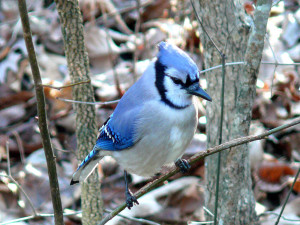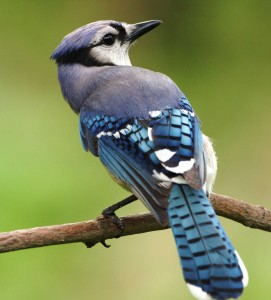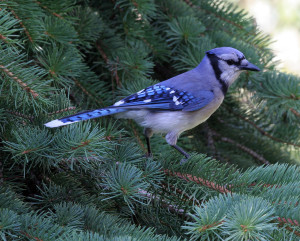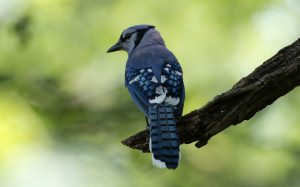Blue Jay Communique
The jarring cry of the Blue Jay echoes in my skull like a radio song repeating itself in an endless loop. It’s like this every spring, when the Jays return to roost in the cedar outside my meditation room window. The only thing to do is to meditate on the Jay.Many birders don’t like Blue Jays. They complain that Jays chase smaller birds away from feeders. Blue Jays can mimic hawks with surprising verisimilitude, making it more difficult to identify birds in the field. Suburbanites find the Blue Jay’s typical cry loud, harsh, and raucous. Homeowners do not appreciate the Blue Jay’s penchant for chipping away house paint, a behavior more characteristic of Blue Jays residing in the Northeast, where sparse sources of organic calcium make calcium-rich paint attractive from a nutritional standpoint. Setting out large numbers of chicken eggs will extinguish this behavior, but this will mean more Blue Jays hanging around your property. I myself don’t mind Blue Jays hanging around. I find it difficult to feel rancor toward any creature so handsome, which has probably been my undoing in life. When humans and animals find ourselves in conflict, it’s usually because we have some sort of commonality. In the case of the Blue Jay, it’s a commonality of habitat. Blue Jays like open areas at the edge of woodlands, and suburban tracts, farmlands, and even large yards within forested regions meet this requirement. People who put out birdseed are calling the Jay, even though the seed is meant for the nice birds who play well with others. Objections to the aggressive territorial behavior of the Jay are interesting, considering humans are the most territorial species on the planet. Another way of looking at this behavior is to see the Jay clearing other birds off the window stage so we can pay more attention to him. His distinctive coloring, pushy behavior, and loud voice say “Listen to me! I’m important!”A territorial inclination is not the only trait we share with the Blue Jay. We plan ahead and stockpile food reserves, going to great lengths to secure our supply. The Jay needs sufficient provisions to last the winter, which is the motivation behind the apparent greediness that some object to. The Blue Jay carries seeds in an esophageal or “gular” pouch, and he is very sneaky and creative in secreting his cache. There are many “trickster” qualities to this bird. As mentioned before, he mimics other birds, especially hawks, and his Red Shouldered Hawk imitation is particularly fine. Actually the Blue Jay has a varied collection of calls, which can make identification difficult. Differentiation between male and female birds can also be challenging. All Blue Jays have subtle differences in pattern, but both sexes look similar, except when they don’t. Occasionally the female will be slightly more drab in color, but this cannot be depended on.Migration is another area where the Blue Jay mystifies those who try to study him. Blue Jays tend to be permanent inhabitants throughout their range, but some Blue Jays migrate; yet not all of them migrate from the same area, and the ones who migrate one year may decide to overwinter the next. There is doubtless a logical explanation for this puzzling behavior, but humans have been unable to discern it. Another Blue Jay behavior in the trickster category is theft. Jays steal from humans and from other animals. Squirrels do not bother to cache acorns when they hear Jays in the vicinity, because they expect to be robbed. In the context of criminality, it’s interesting that Jays are sometimes called jaybirds, while the pejorative “J-bird” (short for jailbird) is used to denote a person who has been incarcerated.Trickster behavior teaches us discernment. The Jay’s mimicry and variety of calls make us sharpen our ears and our memories. Blue Jays themselves are masters of discernment, as the paint chipping example shows. A major component of this bird’s diet is acorns, and while Blue Jays receive nourishment from a nice bug infested acorn, they know enough not to store a weevily acorn for winter consumption, and they are able to discern with high accuracy whether an acorn has been compromised. Oak trees are more dependent on Blue Jays than on squirrels for disbursement, since a Blue Jay can carry an acorn a mile or two away.Blue Jays are members of the Corvide family, which includes not only other Jays but also Magpies, Crows and Ravens. Like Crows, Blue Jays are intelligent, curious, and full of surprises. Whether they find us similarly baffling cannot be known, but Corvides study humans more closely then we study them, and consequently they have our behaviors better catalogued.Ravens and Crows frequently appear in myth to impart oracular insight to the plot. In the ancient art of augury a Crow or Raven appearance held important significance. As a fellow Corvide, the Blue Jay can be seen as a herald, especially since the wild Jay is more talkative and has a greater range of sounds. Blue is the color associated with the throat chakra, which strengthens the link with prophecy. However, the blue coloration means that the Jay does not carry a shadow symbolism like the inward seeking Raven or Crow. The Blue Jay is more extroverted.The Blue Jay’s messages cannot be catalogued for symbolic reference—the cries are too voluminous for that—but he’s definitely got information to unload. He is alert, interested in his environment, and more perceptive than you or I. We can dismiss him as noisy, pushy, and common, but these are the very qualities that call out for our attention. The Blue Jay knows his business—and everyone else’s, too. Sources:Bessette, Alan E. et al. Birds of the Adirondacks: A Field Guide. Utica, NY: North Country Books, 1993.Hilton Jr., B. “Boisterous Blue Jays.” Hilton Pond Center. http://www.hiltonpond.org/ArticleJayBlueMain.html.Marzluff, John M. and Tony Angell. In the Company of Crows and Ravens. New Haven, CT: Yale University Press, 2005.Seriously Science. “The Blue Jays are Coming! Hide Yo Kids, Hide Yo Nuts!” Discover Magazine. http://blogs.discovermagazine.com/seriouslyscience/2014/05/07/blue-jays-coming-hide-kids-hide-nuts/.The Cornell Lab of Ornithology. “Blue Jay.” http://www.allaboutbirds.org/guide/blue_jay/lifehistory.





